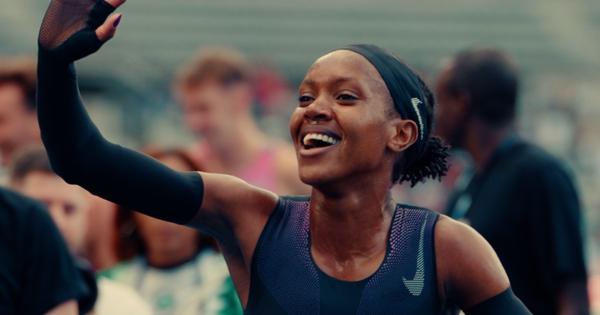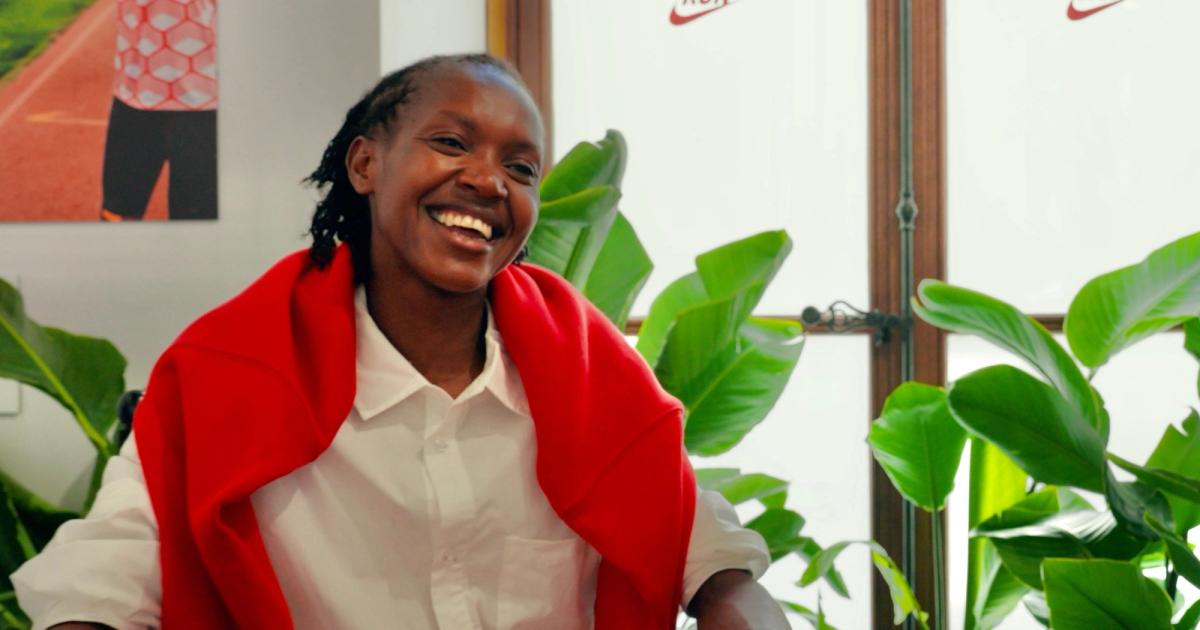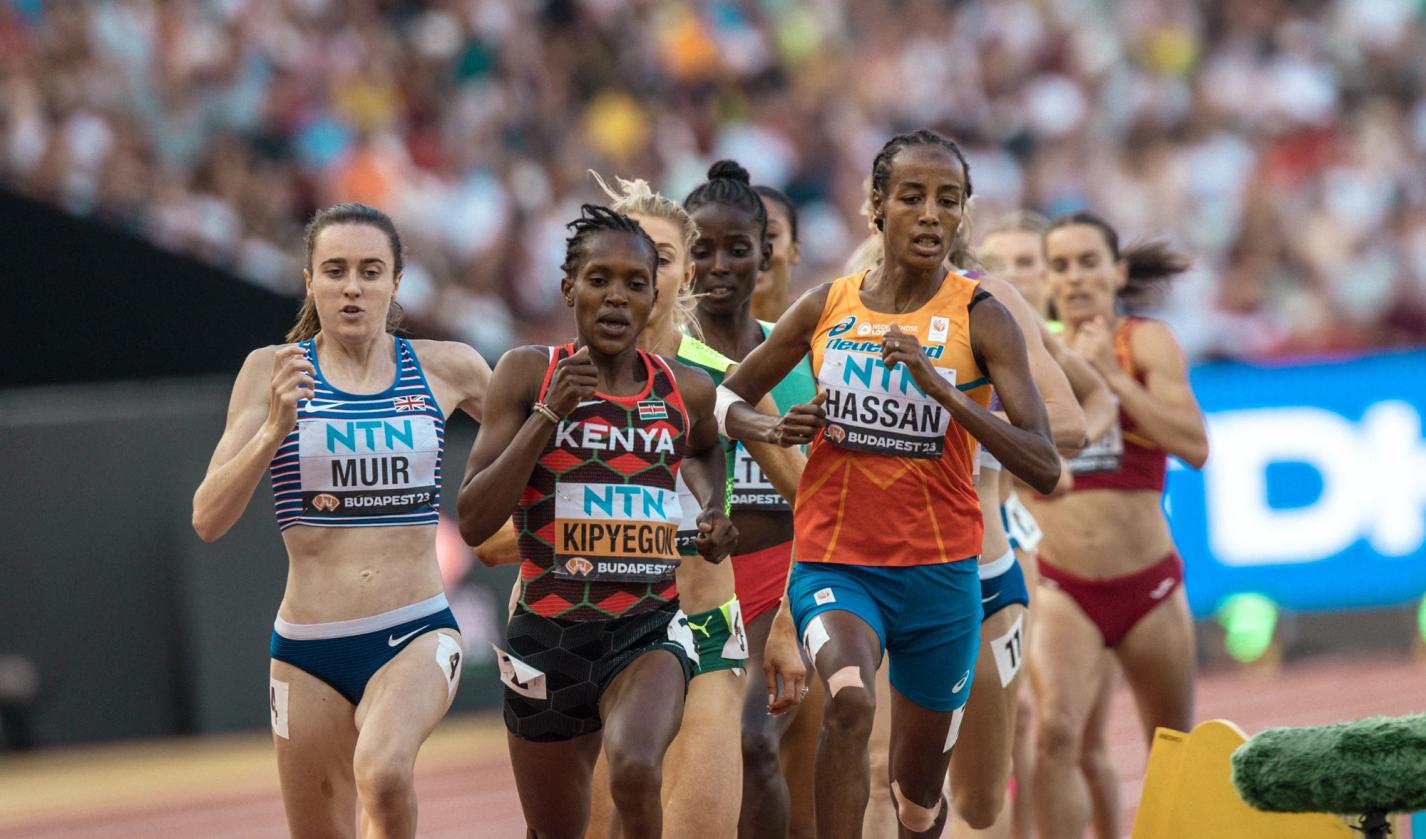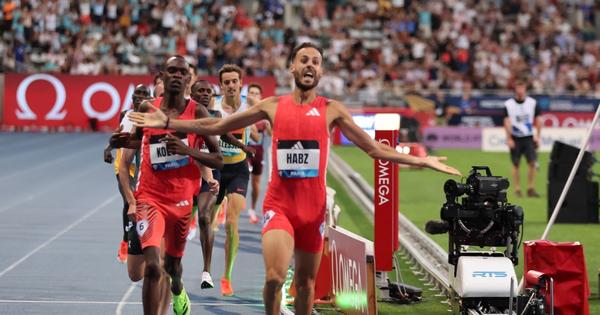By Keenan Baker
June 30, 2025
For those who follow running, Faith Kipyegon needs no introduction.
But if you just arrived to track and field fandom yesterday, you’ll quickly learn about the greatest women’s middle distance runner, potentially track athlete, of all time: Kipyegon is the world record holder for the mile and the 1500m and has won three straight Olympic gold medals in the 1500m.
She made her debut on the international stage in 2010, finishing in fourth at the U20 World Cross Country Championships in Bydgoszcz, Poland, as a barefoot sixteen-year-old, then began her ascension through the ranks, winning her first World 1500m title in 2013, followed by an Olympic gold medal in 2016 and another World title in 2017, both in the 1500m.
Had she retired from running in 2018, at age 23, Kipyegon would’ve already cemented her place as track and field royalty.
And Kipyegon did stop running for a time. Not because she was tired of being the best (à la Michael Jordan), but because she had her child, Alyn. The world’s best runner didn’t run for a year and a half, and didn’t race for two years.
When she did race again, it was like she never left. After winning silver at the World Championships in her first season back in 2019, she picked up two more Olympic golds in the 1500m (in Tokyo and in Paris) along with three world records, two of which are still standing. She has run a mile almost five seconds faster than the next fastest woman, 4:07.64 to 4:12.33. And while her competition is closer in the 1500m, no woman in history has run faster than 3:50—except for her.
There is no hill she hasn’t climbed, once, twice, three times over.
Except for one big one.
It was eight years ago when Nike ushered the running world into its space race era with their first “moonshot” at the Breaking2 project. The end result was an agonizingly close 2:00:25 run by Eliud Kipchoge that was still over two minutes quicker than the then-world record.
Nike missed their moonshot, but Kipchoge, a mentor to Kipyegon and the GOAT of marathon running, didn’t give up. His second attempt at breaking two hours for the marathon, hosted by INEOS, left him as the only man to ever run under two hours for the distance. Kipchoge’s inspirational running (and inspirational quotes) validated the need for big goals and big efforts—or at least, the want for them.
It was big for Nike, too. Everybody wanted carbon-plated shoes, specifically the 4% and its successor, the Alphafly. Most people didn’t know what to do with them (it could be argued they still don’t, if you peruse the #alphaflysinthewild hashtag), but they knew the shoes were fast. One big step for Nike, one slightly-more-efficient leap for run clubs worldwide.
As Kipyegon, like late-2010s Kipchoge, has practically run out of career achievements to cross off her list, it’s less surprising that Nike wanted to do Breaking4 than it was that they waited this long.
This time around, Nike had a higher bar to cross: the two hour marathon was 2.41% faster than the world record at the time, and a four minute mile is 3.14% faster than the current world record. There were fewer obvious areas to make vast improvements, too. Nike couldn’t reinvent carbon-plated shoes. Nor could they move the location to be any flatter or faster, as they did with the marathon. Making larger strides over shorter distances in an already controlled environment would require even more groundbreaking innovation.
“Faith is at the center of making up most of it—I mean, she's the athlete doing it. But you start to obsess over all these little things, and you start to look at all of it and then the little things add up,” said Elliott Heath, a footwear product manager for Nike. “Any runner knows that the little things in training add up to big gains over time, and so that's kind of the approach that we've taken with all these little pieces.”
The aforementioned “little pieces” include, but are not limited to: racing spikes specifically engineered for her feet that included higher Zoom air pods in the forefoot a three-paper-clip-light upper, and titanium spikes embedded into the shoe. The shoes are the Victory Elite FK—FK for Faith Kipyegon and Fastest Known. Printed on the bottom of the spike is an image of the Niké of Samothrace statue, a fitting place for the goddess of victory.
And it’s not just the shoes. Kipyegon wore a one-of-one speedsuit that was designed to reduce drag because, according to VP of Nike Sports Research Lab Amy Jones Vaterlaus, “skin is actually quite slow.”
The ultraslick suit was built to minimize drag and maximize speed, as well as comfort. It was paired with a brand-new digitally-printed TPU-based bra. But the suit and the bra weren’t enough, either, and Nike turned to drafting to further minimize drag.
Air resistance is more important the faster people move, hence why competitive cyclists care so much about drafting and aerodynamic helmets (the bigger the better). But runners started to take notice after a research article titled “Could a female athlete run a 4-minute mile with improved aerodynamic drafting?” was published in February of 2025. The authors theorized, while improbable, it was possible that Kipyegon could break four minutes if drag was properly reduced. They knew that the only way to possibly know, though, was to put theory into practice: “Hopefully, Ms. Kipyegon can test our prediction on the track.”
Nike bought into it. Though the confirmed number of pacers was under lock and key until race day, when everyone lined up, Kipyegon was flanked by 13 of Nike’s fastest runners—eleven more than the recommended two referenced in the study.
Prior to the attempt, Kipyegon raced only once on the track this season, a benchmark attempt at the 1000m world record (that just barely missed her PB and the WR) in Xiamen, setting aside other events for an attempt at history. When the day of the attempt finally arrived, Mother Nature was relatively well behaved, and the rain held off.
On June 26th, 2025, the Stade Charléty was completely transformed after the previous week’s Paris Diamond League. The blue track is typically a shock on its own, but now the infield, rather, the stadium was covered entirely in purple. The royal purple turf/fur surrounded the broadcast stage and video board—the broadcast called it “Faith’s power color.”
All of the seats on the backstretch were covered by tarps bearing the Breaking4 logo. On the homestretch, the stands were moved up to cover the long jump pit. Not exactly Franklin Field, but it did bring fans closer to the action. The most lively section of the crowd stood along the first turn, where local Parisian run club Eight8Lines made their presence known by chanting, singing, and cheering like no one else.
It still made for an odd contrast to the Paris Diamond League, which was a sell-out crowd 19 thousand strong. The people who did attend Breaking4 were mostly boisterous, especially those sitting in the background of the broadcast stage, and it was clear Nike spared no expense in the production.
But it was still emptier than it should’ve been—especially in a city that so clearly loves track and field. The vibe was relatively muted, and a bit tense. Ego Nwodim of Saturday Night Live and the stadium announcers did the best they could to hype up the crowd, but things didn’t truly wake up until the pacers began to enter the track.
The pacers walked out, one-by-one, from Craig Engels to Jemma Reekie to Niels Laros to Wycliffe Kinyamal, all world-class Nike athletes. The cheering and chanting peaked when Kipyegon jogged out to the sound of Shakira and did a few strides, dressed in her all-black speedsuit. She lined up, did a few stretches, took quite a few deep breaths, and smiled at the crowd. As small groups chanted “Go Faith Go!” across the stadium, the clock struck 0.
Time to Break4.
Let’s get the facts out of the way:
Ultimately, Faith Kipyegon ran 4:06.42 for a full mile to unofficially break the world record, but failed to hit the prescribed goal time of 3:59.99. Flanked by pacers in varying quantities and positions, she ran splits of 60.20 for the first lap, 60.55 for the second lap, 61.09 for the third, and 64.58 for her final lap. She ran 1.22 seconds faster than her own recognized world record, but was over six seconds shy of her prescribed goal.
Note: The clock time was slightly different at first. Nike contacts later confirmed to us afterwards in a call that they measured the time from which Kipyegon moved to when she crossed the line—like chip times in mass road races.
It’s still an open question whether Nike fully optimized their pacing and drafting strategies. There are valid concerns about the efficacy of negatively splitting a race where staying in a draft and being on pace is paramount. If Kipyegon fell off the pace, would she lose the drafting benefit that would enable her fastest time? Would that not make her work doubly hard over the closing stages? Everybody knows that the third lap is the hardest lap in the mile—and that’s when the drafting benefit seemed to pull away, and her pace started to fall back.
The pacers’ performance was described as “ideal” by Brett Kirby, the performance integration lead for Nike. “There were some movement patterns that those teammates executed perfectly,” added Kirby. “So it was as we hoped for the execution of the pacing.”
Kipyegon’s response, when asked about the results, followed a similar line of reasoning.
“If I was to hold back, I could run like 4:02 or 4:03 or below the world record,” reflected Kipyegon. “But it was all about how fast I can execute, how fast can I run, how much energy do I still have in my body?”
The resounding sentiment in conversations with both Nike and Kipyegon was that this truly was a moonshot—where success was far from expected. Their approach was: Do what you can, with the information you have, and improve when there is an opportunity to do so. Nobody has run a race like this before. Now we know.
“Of course, Faith gave her best,” Kipyegon’s coach, Patrick Sang, assessed. “Looking back, is there anything that we could have done better? I don't think so. We gave our best in planning and execution, and today, she gave her best.”
It’s clear that Kipyegon wants to keep making big leaps and take moonshots.
“I know one day, one time, a woman will run under four minutes,” said Kipyegon. “How I executed yesterday? It gave me hope that I think this, this breaking four will one day go down.”
Are people going to wear speed suits and buy stick-on aeronodes to minimize drag in their local 5ks? Probably not. Compared with Breaking2, the event was less about celebrating technical innovation and more about celebrating Faith, the athlete, and women worldwide.
Regardless of what happened on the track last week, Kipyegon is already a life-changing presence in the sport. The studies, the suits, the bras, the shoes—they’re tools to enable a generational talent to do her best. They don’t define her, and they don’t overshadow her. It’s bigger than the sport, these events, and the opinions about them. It’s bigger than Nike.
For Kipyegon, it was about women and their place in the world.
“The whole set up of this race was all about sending messages to the younger generation—sending messages to women out there to know that we can expand our boundaries,” said Kipyegon. “We can expand our limits. We don't have to limit ourselves.”
During a press conference after the race at Nike HQ in Paris, Nike announced they are building a maternity ward in Kipyegon’s hometown of Keringet. It was named Dare To Dream, after Kipyegon’s consistent proof that she dared to dream—not just with Breaking4, but her whole life. The barefooted teenager running in the cold of Bydgoszcz, Poland, became a mother and a movement. She’s a world record holder, an Olympic champion, and an inspiration.
But on that day in Paris, amidst all the pomp and circumstance, it was Faith against the clock.
And as she crossed the finish line cheered by her pacers, the stadium, and the world, Faith Kipyegon fell down. And stayed down. The crowd quieted, watching her lie on the ground motionless, cloaked by the Kenyan flag.
Was she okay? Was she hurt? Was she upset?
A few moments passed before she sat up, bearing the biggest smile. She knew the time, that she failed to break four minutes. That didn’t matter to Faith. She knew, like we know now, that one failure pales in comparison to the chance to change lives.
___________________
Keep up with all things track and field by following us across Instagram, X, Bluesky, Threads, and YouTube. Catch the latest episodes of the CITIUS MAG Podcast on Spotify and Apple Podcasts. For more, subscribe to The Lap Count and CITIUS MAG Newsletter for the top running news delivered straight to your inbox.
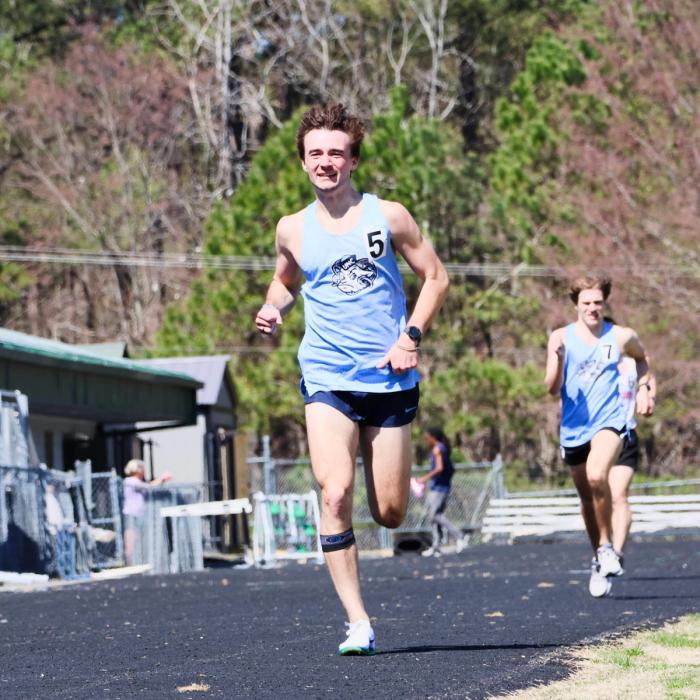
Keenan Baker
Keenan Baker is a track fan. He’s also a journalism major and writer at UNC-Chapel Hill. Putting both of those passions on the page together is the goal, and he looks forward to covering more track and field with CITIUS MAG this summer!
